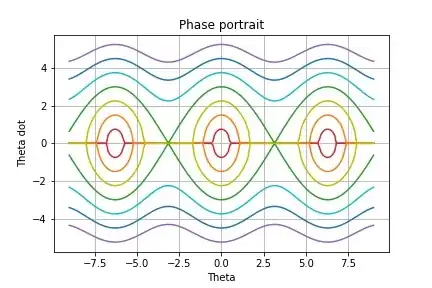How are the other curves i.e. the curve intersecting y axis at +2 created?
The trick behind understanding that phase portrait is realizing that the 'amplitude' is not the fundamental quantity which acts as the difference between those lines.
The amplitude of a pendulum is usually considered to be the angle or displacement at which the velocity is zero, according to conventional intuition. But we see that the line you pointed out, the one with a maximum angular velocity of $2$, never reaches $\frac{d\theta}{dt}=0$, so a 'pendulum'described by that line won't have an amplitude according to our usual definition.
The solution? You need to think of maximum angular velocity as the fundamental quantity instead. For every pendulum shown by that phase portrait, the maximum angular velocity will be at the lowest point of the pendulum's trajectory. So each line in that phase portrait depicts a different trial with the same pendulum, except the angular velocity at that lowest point is different each time.
Think of performing an experiment to test the behavior of your pendulum for different amplitude angles, but each trial, instead of dropping the pendulum from a different position, you launch it from that same base point with a different velocity. And obviously $v=l\dot{\theta}$, where $\frac{d\theta}{dt}=\dot{\theta}$, so you'll be starting with different initial angular velocities.
What equation gives that and how would the pendulum's motion look?
Now let's consider you start the pendulum with a really high angular velocity... it'll eventually end up moving in a complete circle! When the pendulum reaches $\theta=\pi$, it'll still have some kinetic energy, and it'll descend on the opposite 'side' of the pendulum's pivot.
When you're at the lowest point, you'll have the greatest velocity and hence the greatest angular velocity. As the height increases, the potential energy increases, hence the kinetic energy decreases and the angular velocity decreases. And thus you see a minimum, but nonzero angular velocity when $\theta=\pi$ according to the phase portrait.
How would such an equation be derived?
Conservation of energy works again, though the Lagrangian may be easier. You know the initial kinetic energy, because your initial conditions give you $l$ and $\dot{\theta}_{max}$. Also, at any angle $\theta$, the potential energy is $mgl(1-\cos\theta)$. If you consider the energy at a couple of different points and equate them, you'll get $$\dot{\theta}=\pm\sqrt{\dot{\theta}_{max}^2-\frac{2g(1-\cos\theta)}{l}}$$
I may have mentioned that I'm a huge fan of ultra-colorful diagrams, so here's one I threw together. It's much clearer than the monochrome thing in the question.


